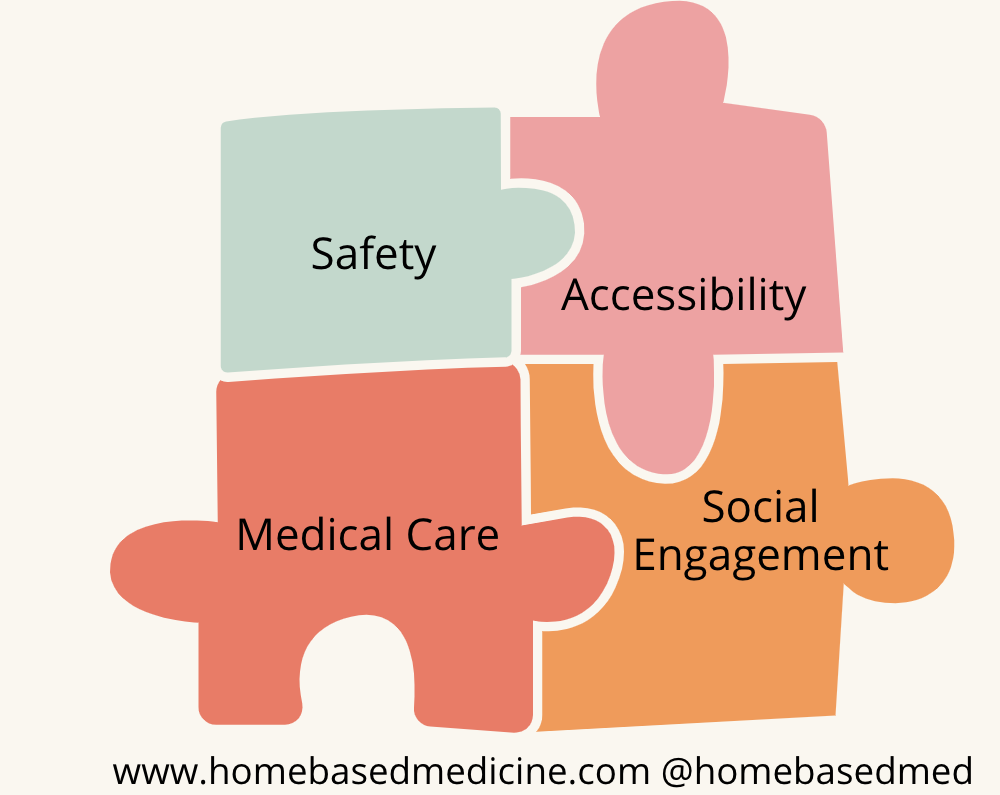Home Sweet Home: Aging in Place with Safety, Style, and Support
By Gurpreet K. Padam MD, FAAFP
Aging in place is a popular choice for many people. According to AARP, nearly 90% of adults over 65 want to remain in their current homes as they age, yet only 25% do. There is an apparent mismatch between what people prefer and where they end up. However, by planning and addressing various aspects that may impact one’s quality of life, such as home safety, accessibility, social engagement, healthcare at home, support services, and living options, individuals and their loved ones can be proactive and help facilitate a successful aging-in-place plan and provide a smooth transition when the time comes.
Amidst our preoccupation with taxes and mortality, we overlook the importance of aging gracefully and living well.
Consider the following areas:
Aging in place and caring for someone who is homebound can feel like a puzzle; each component must fit together correctly to succeed. By considering these aspects and taking proactive steps, individuals and their loved ones can prepare for aging in place and design solutions for their safety, health, and well-being.
- Home Safety: Evaluate potential hazards such as slippery floors and uneven surfaces. Installing safety features, like grab bars and non-slip surfaces in high-risk areas like the bathroom and kitchen can prevent falls and other accidents.
- Accessibility: Consider mobility or any anticipated mobility issues to make homes accessible. For example, installing ramps, lifts and modifying doorways to accommodate walkers or wheelchairs.
- Social Engagement: Aging in place can lead to isolation, so exploring opportunities for socialization and community engagement is essential. Finding local senior centers, clubs, or organizations can provide a sense of connection and purpose.
- Primary Care at Home: Access to healthcare is vital for older adults. Ensuring healthcare providers and services are available in the community and that there are transportation options to appointments is critical. For those who are unable to make it to their primary care doctors office, in-home and primary care services can provide valuable support for homebound patients. The primary care visiting physician oversees well-being and sick care that would otherwise require a doctor’s visit. A physician can also initiate appropriate referrals to home health services such as occupational therapy, physical therapy, speech therapy, swallow evaluation, and nursing care (wound care, chronic conditions management, transitional care, palliative care, hospice, home health aide, and social worker).
- Home health services: to help improve quality of life and maintain independence. Typically a primary care physician or provider can initiate a referral if appropriate.
- Support Services: Support services can help older adults maintain independence. For example, meal delivery, housekeeping, and transportation services can be beneficial. Local resources can help with home modifications and repairs, such as installing ramps and grab bars.
- Transportation: Patients receive transportation services to get to appointments. These services allow older adults to remain in their homes longer, reducing their risk of falls and other health problems. For example, transportation services can coordinate rides to and from the doctor’s office or pharmacy to pick up medications. Approximately 10% of seniors who live in cities use public transportation.
- Meal delivery: Meal delivery services provide a convenient way for seniors to receive nutritious meals tailored to their nutritional and preferred food choices, medical necessity, and cultural and ethnic food needs.
- Home modifications: Resources for home modifications, such as ramps or grab bars, to help them maintain independence. Home modifications allow seniors to stay in their homes for longer and can help reduce the risk of falls and other injuries.
- Housekeeping services: help elders stay independent, such as help with grocery shopping, laundry, cooking, and cleaning. For instance, a housekeeping service could offer assistance with grocery shopping or meal delivery to help prevent elder malnutrition or dehydration.
- Living options: If a person cannot live in their own home, there are options such as local board and care or other senior residential facilities when they need more hands-on care. For instance, a board and care home is a private residence that provides room, board, and personal care services to a small number of residents.
In addition, a plan can ensure a smooth transition to the aging-in-place process. Making informed decisions about resources available, such as transportation services, meal delivery, home health services, and local senior residential facilities, are some of the resources that can help develop a successful aging-in-place plan. Check out this comprehensive resource.
#homecare #housecalldoctor #homebasedmedicine #homebound #aginginplace #medicalcare #compassioninaction #compassionatecare #primarycare #primarycaresanmateo
